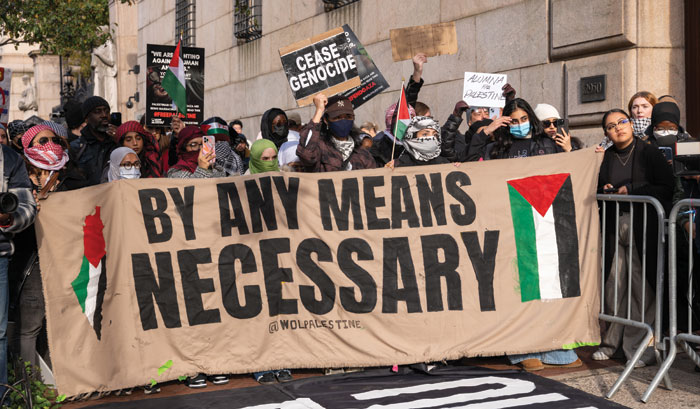Plastic or paper?
Lior Alkoby was never asked that question during a recent Sunday morning trip to Super Sal Market in Encino. He checked out, wheeled a cart brimming with plastic bags half-filled with fruits, vegetables and canned goods to the parking lot and loaded them into his SUV. For Alkoby, the lack of choice was a non-issue.
“I throw the bags away, just like everyone else,” he said.
Super Sal Market, like many small stores, offers only plastic bags. And Alkoby, like most Americans, tosses them in the trash.
In fact, of the estimated 92 billion plastic bags consumed in the United States annually — 19 billion in California and 6 billion in Los Angeles County alone — less than 5 percent are recycled, according to the nonprofit environmental organization Californians Against Waste.
“I don’t have time,” Alkoby said.
Millions of these bags, unlike Alkoby’s, don’t even make it to a trash bin and eventually a landfill. As a result, plastic bags can be found clogging gutters and storm drains, billowing out from tree limbs, blighting neighborhoods and choking off birds and marine life.
“Plastics are bad,” said Lee Wallach, president of Coalition on the Environment and Jewish Life of Southern California (CoejlSC). “As with most other things, we have to start thinking about the lasting impact.”
And for non-recycled plastic bags, which are made from non-renewable resources such as petroleum, natural gas or other petrochemical derivatives, the lasting impact translates to a life expectancy of a thousand years or more.
But paper, surprisingly to most people, is not the answer either.
“Paper bags are an enormous user of natural resources. They take four times the energy and emit over 70 percent more global warming gases than plastic bags,” said Lisa Foster, founder of the reusable tote company One Bag at a Time.
In addition, paper bags are more costly to produce and are responsible for considerable deforestation, using 14 million trees to make the 5 billion paper bags that Americans use each year. Less than 20 percent of those are recycled.
And while paper bags do biodegrade, that can’t happen in a landfill, which lacks the necessary oxygen, sunlight and water. In fact, a municipal solid waste landfill, which receives household waste and other non-hazardous materials, is not meant to promote biodegradation, according to the U.S. Environmental Protection Agency’s Web site. Rather, federal regulations require that these landfills have impermeable barriers to contain the waste and thus protect surrounding areas.
“A landfill is really just a big garbage bin,” Foster said.
So what’s the solution?
For California Assemblymember Lloyd Levine (D-Van Nuys), it starts with recycling. He sponsored Assembly Bill 2449, which went into effect July 1, 2007, and requires grocery stores with more than $2 million in annual sales and pharmacies with more than 10,000 square feet of retail space to establish at-store recycling programs for plastic carry-out bags. Those retailers must also sell reusable bags. The bill, however, precludes local governments from assessing a fee on plastic bags though individual retailers may impose one.
Building on the success of that bill, Levine introduced Assembly Bill 2058 on Feb. 19, which would require retailers to reduce plastic bag usage by 35 percent by July 2011 and by 70 percent by July 2013. If those objectives are not met, those businesses will be charged a mandatory 15 cents fee per bag.
“The goal is to reduce litter, not produce revenue,” Levine said, explaining that people need education and time to make lasting behavioral changes.
San Francisco, however, became the first U.S. city to ban plastic bags outright when the Board of Supervisors passed the Plastic Bag Reduction Ordinance in March 2007.
Effective November 1, 2007, for grocery stores with more than $2 million in annual sales and March 1, 2008, for large chain pharmacies, plastic bags made from petroleum products are outlawed. These retailers can distribute only compostable plastic bags, paper bags made of 40 percent recycled materials or reusable bags.
According to Dave Heylan, vice president, communications for the California Grocers Association, member stores in San Francisco that are subject to the ban on noncompostable plastic bags, representing a majority of grocers, have all opted to go straight to paper rather than to offer compostable plastic, which can cost upwards of 15 cents per bag.
As for the higher price of paper bags, which cost 5 to 9 cents per bag while plastic bags cost 1 or 2 cents each, “We haven’t seen any numbers, but retailers typically don’t share those,” he said. “But we have not heard any complaints.”
Santa Monica is moving in the same direction. On Feb. 26, the Santa Monica City Council voted unanimously to instruct the City Attorney to draft an ordinance banning single-use plastic carryout bags, including biodegradable plastic bags, at all retail outlets within Santa Monica and to explore imposing a fee on single-use paper bags.
But in Los Angeles, on Jan. 22 of this year, the County Board of Supervisors adopted a voluntary ban on plastic bags for large retail stores. A mandatory ban kicks in only if stores cannot coax customers into reducing their plastic bag usage 30 percent by July 2010 and 65 percent by July 2013.
Many environmentalists criticized the County Board of Supervisors for adopting what they considered a weak ordinance.
“It’s too little too late,” CoejlSC’s Wallach said. “They ducked the issue. This is the time for bold action.”
One Bag at a Time’s Foster, however, applauded the collaborative effort, as she is not a proponent of banning plastic bags.
“It’s a great sound bite, but not a great solution,” she said.
Neither does she favor recycling, which she believes is more “to assuage our guilt over over-consumption.”
Foster suggests that people become educated about the true cost of a bag — be it plastic, paper or a reusable material — by assessing the total costs of manufacturing, usage and disposal.






















 More news and opinions than at a Shabbat dinner, right in your inbox.
More news and opinions than at a Shabbat dinner, right in your inbox.